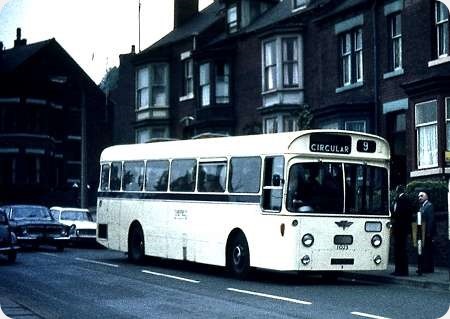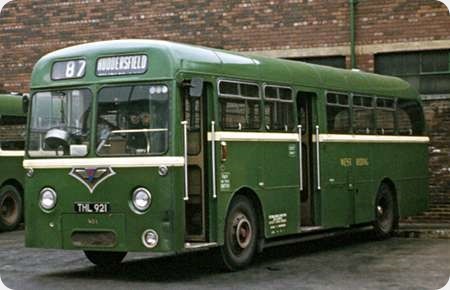
Sheffield Corporation
1968
AEC Swift 2P2R
Park Royal B53F
Sheffield took delivery of two batches of AEC Swifts in 1968. The 2P2R type was fitted with the AH691 engine, ideal for the Sheffield hills. The first 11 buses were single doorway for the Joint Committee B fleet as shown here. These buses were initially put to work on the Inner Circle services 8 and 9 despite these being category A services. 1023 is seen here so employed when just a few weeks old at Hunters Bar. The Inner Circle routes took one hour for a round trip serving the older and inner parts of the City. The small window beneath the nearside windscreen had a roller blind behind which could be set to either blank (as here) or Please Pay as you Enter as appropriate.
Photograph and Copy contributed by Ian Wild
29/06/20 – 06:21
Who knows? I could have been lurking within 1023. I was a pupil of King Edward VII School on Newbold Lane from 1964-1971 and these were my regular mode of transport to and from school from 1968. Fast and smooth but, in retrospect, not the equal of the RE. Ironic that, shortly afterwards, an order for the superb RE was changed for the flawed VRT.
David Oldfield
15/07/20 – 06:45
I think you and I spent many a happy hour waitiog for these Swifts and before that – whatever could be mustered from East Bank Road depot at that time in the morning, be it a 30ft long AEC Regent V with Weymann, Alexander or Roe bodywork, a PD3, Atlantean, Fleetline or even somethingg older. What a splendid mix was the Sheffield fleet right up to the 1970s.
The Swifts had a hard life climbing up and down the ferocious hills of the Steel City to Lodge Moor, Gleadless, Upperthorpe, Walkley and, as here, on the Inner Circle. Of course they never looked as good as this once taken over by the South Yorkshire PTE.
Philip Hanwell
17/07/20 – 07:33
Yes, it was a bit of a hotch potch just prior to the Swifts. Not sure about the B fleet Regents Vs or Fleetlines, but we certainly had the rest – and older. [Not to mention the fleet of almost retired Regent IIIs and PD2s used to ferry us to games at Trapp Lane and Castle Dyke.]
David Oldfield
Quick links to the - Comments Page - Contact Page - Home Page

Yorkshire Woollen District
1961
AEC Regent V 2D3RA
Northern Counties H39/31F
Yorkshire Woollen was fundamentally a Leyland operator, apart from a few Guy Arabs in the early post war years. The first YWD Regent Vs appeared when ten Metro Cammell H39/31F bodied buses of the LD3RA type were delivered in 1958, to be followed by fifteen more in 1959, but these were of the 2LD3RA variety. The following year saw the arrival of another nine, still with Metro Cammell bodies, but the chassis was now the 2D3RA. Early in 1961 came a further ten, FHD 116 to 125, with the original fleet numbers 842 to 851, but these had the much superior Northern Counties bodywork of similar capacity. By 1966, with fleet numbers approaching 1000, the fleet was renumbered, and the Northern Counties batch became 89 to 98 inclusive. Photographed in August 1970, Yorkshire Woollen Regent V FHD 121, now carrying the number 94 is seen in Bradford in the company of others of its kind operated by Bradford Corporation. By this time, in NBC ownership, this nine years old bus is beginning to look rather shabby at the front end.
Photograph and Copy contributed by Roger Cox
23/06/20 – 06:41
It may be worse for wear at the front but a plus point is that it has reverted to a chrome radiator surround. Previous models of this batch prior to the cream band addition (mid sixties?) had the radiator surround painted red.
John Blackburn
24/06/20 – 06:29
Is this bus unusual in having the original YORKSHIRE signage in pre-NBC style, or was this common to the fleet and unique in NBC?
Chris Hebbron
25/06/20 – 07:16
Taken in August 1970 this picture would predate the corporate identity that didn’t begin to appear on buses until 1972
Ken Aveyard
Quick links to the - Comments Page - Contact Page - Home Page

West Riding Automobile
1961
AEC Reliance 2MU3RV
Roe B41D
In 1956 West Riding turned to the AEC Reliance for its limited bus saloon requirements, taking twelve with Roe B44F bodies characterised by a ‘droopy’ lower line to the windscreen. www.old-bus-photos.co.uk/
The Reliance then became the choice for the coach fleet with Roe C41C bodies, and in 1961 twelve of the 2MU3RV chassis type arrived carrying Roe B41D bodywork of which THL 921, fleet number 921 is an example. No more Reliances were purchased before West Riding sold out to the National Bus Company in 1967. This picture was taken in April 1970 before the corporate dead hand of Freddie Wood fell in 1972, after which the poppy red livery was inflicted upon West Riding.
Photograph and Copy contributed by Roger Cox
18/05/20 – 06:38
A stylish yet functional design enhanced by a smart livery. More attractive than the standard (Alexander in the cases of PMT and Trent) BET version of the time.
Ian Wild
17/06/20 – 07:19
These dual bodied Roe bodied Reliance saloons felt very solid indeed. They lasted until 1973 when they were ousted by new Leyland Nationals. None of the batch was repainted into National Bus Company red, and these along with the elderly Guy ArabIV of 1957 vintage stood out from the mainly repainted fleet by early 1973. They were probably the last traditional green single deckers in service.
MarkyB
18/06/20 – 06:45
I was recounting, only last week, to a friend retired from the industry that C H Roe were among the coachbuilding greats and, against a general trend and tide, retained a composite structure which produced high quality bodies of a generally attractive appearance; robust, well built and well finished. These, and the traditional deckers, were among the best bodies available (in every sense). Following in Crossley’s footsteps, the introduction of PRV frames (particular on the Atlantean and similar bodies on various front engined chassis) brought the nadir of Roe bodywork. They were ugly in the extreme and time revealed them also to be rot boxes. They did solve these problems – but not in the OBP era.
David Oldfield
03/05/21 – 07:19
A snippet of information for fans of the AEC Reliance. A 1961 AEC Reliance (WKG 287, the last of a sequence number-plated WKG 276-287) was still in daily service with Henley’s of Abertillery, Wales in the 1990s, making it the oldest service vehicle still in daily use on a public route.
Julian Meek
Quick links to the - Comments Page - Contact Page - Home Page



